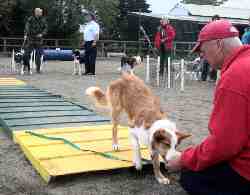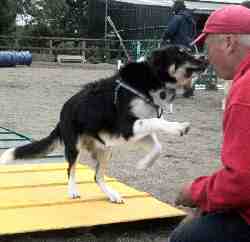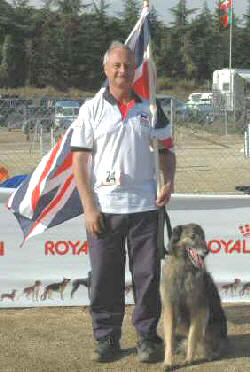|
|
|
Co-sponsors of the 2023 Winning Out
Certificates |
Taking teaching seriously but making it fun
|
 |
Module 1 - Starting Agility Training Module 2 - Starting to Teach Agility Module 3 - Teaching Handling Skills |
When we have groups of students that doesn't have much agility experience - sometimes they have none at all but have been asked to start teaching agility for a pet dog club or kennels - we do one module per day. But when we have a group of students who've had previous experience of agility and/or instructing dog training - some have already been competing successfully and instructing - we send them a copy of the course syllabus in advance so they can select the topics they want to focus on. In this case, we can combine Modules 1 and 2 and run them both on one day, adjusting the course to fit the students' experience.
A good example of how this works happened when I was asked to go to the Isle of Man to run a course. They had a group of instructors, all with similar agility experience, so we were able to ascertain in advance what they wanted to cover. They were a great group of students with a positive attitude towards dog training and agility, but I found it much harder work than usual as I did not have my back-up team, demonstration dogs or special training equipment.
 For Modules 1, 2, and 3 we give a
Certificate of
Attendance. Students can choose to have their practical work assessed and to do a multi-choice
question paper for each module. The question paper is a sort of test but it done in a way that,
we hope, is not too stressful. It includes questions that are designed to make people think and
some to make them smile. If they get more than 80% percent correct, they get a Certificate of
Competence.
For Modules 1, 2, and 3 we give a
Certificate of
Attendance. Students can choose to have their practical work assessed and to do a multi-choice
question paper for each module. The question paper is a sort of test but it done in a way that,
we hope, is not too stressful. It includes questions that are designed to make people think and
some to make them smile. If they get more than 80% percent correct, they get a Certificate of
Competence.
Just over 100 people have taken the course so far, and there has been a 95% pass rate. The question paper is a very useful way for us to assess their progress and the course in general. If a lot of students give the same incorrect answer, we change how we are teaching that topic. It is also helps the students know what areas they need more work on.
There is a lot to take in on the first course in either the one or two day format. We strongly feel that people need some time to review and practice what they have learnt. For this reason, we ask people to wait several months before coming back for Course 2. That way they can let us know from personal experience what has gone well and what has not, and we can incorporate help into the second course. We also know the people by then - their strengths and weaknesses - which helps the focus of the course on the needs of the individual.
 Course 2 consists of Modules 4 and 5
Course 2 consists of Modules 4 and 5
Module 4 - Competition Coaching
Reviewing the previous modules and continuing with advanced handling skills. It covers coaching techniques, goal setting, planning, motivation for people and dogs and is mainly practical with some theory.Module 5 - Problem Solving
Covering three areas, specifically 1) Behavioural Problems, 2) Dog Training Problems and 3) Agility Problems. We look at how to identify problems early and what is the best way to deal with them. If we can find dogs with a relevant problem we use them for practical work. If not, we discuss what can be done. To be honest, we are never short of examples from the students' own experiences.
We only give Certificates of Attendance for Modules 4 and 5, though there is a course quiz used for review.
The average course size has been 8-10 people. The smallest was six and the largest 12. For the practical sessions and the quiz, we split into teams of three or four, carefully selected to give a balance.
The courses are usually held at Orchard Farm, Kenn, North Somerset BS21 6TT, a few miles from M5 J20. We have an outside sand arena, a grass training paddock and a small barn where the theory and some of the practical lessons are held. We are unable to offer camping, but there are is hotel, B&B accommodation and campsites that accept dogs nearby.
 Diamond
training
Diamond
training
In our own training classes, we cater for both the competition
handler and for the pet dog owner who just wants to have some fun and exercise with their dog.
We believe that competitive agility can be fun and fun agility can be competitive so whichever
their goal, we always train as if the person might want to compete at some time in the future. It's
quite difficult to change from pet training to competition when the owner
suddenly realises that they have a star. We follow the same principle in our instructor's
courses.
Throughout the course, we encourage people to study all methods of dog training and dog sports, not just agility and to take what they feel is most appropriate to them. Even if it is not a technique they have used themselves, they should at least know about it as one of their students is sure to ask about it at some time. Most importantly, we encourage them to try things for themselves and make their own minds up about what will suit different dogs and people.
We have always loved dogs and enjoyed dog training, competing and instructing. Agility has been a huge part of our life. Because of it, we have travelled to many places and met people whom we would not met have otherwise. Through agility, we've made many good friends and, above all, we've tremendous fun. Running instructors courses is hard work and is very demanding but the positive feedback we get makes it all worthwhile.
More information about the instructor’s course can be found at www.diamond-dog-training.co.uk
 About
the author...
About
the author...
Mike Bacon has been dog training for almost 40
years. He competed successfully in Obedience and Working Trials until specialising in Agility
26 years ago. With Jack of Diamonds, his Tervueren (BSD) he came 6th in the FMBB Individual
Agility World Championships in Spain 2004 and was a member of the winning team in Germany 2005.
He was appointed by the BSDA and WBSDS to be the Team Manager of the Great Britain Agility
squad for the FMBB World Championship since 2006. His current Tervueren, Jet competed in the
2010 FMBB World Championships and is now competing in Grade 6.
Mike also trains his collies to work sheep but does not trial with them as he likes to have at least one dog activity that is done just for the fun of it. For same reason, he trains tracking and searching with his BSDs but does not compete in Working Trials. He runs workshops for like-minded people. He also works with people and dogs with training problems, specialising in stock chasing and dog aggression.
Mike set up Diamond Dog Training about ten years ago to provide 1-2-1 training to people who needed a bit more attention than they could get a training clubs. It was so successful that he took early retirement from his job as a project manager with an IT company to concentrate on dog training. In 2009 his daughter Claire joined him, helping with the agility and puppy classes so that he could spend more time dealing with problem dogs.
Mike is an Agility Club Approved Instructor (ACAI), member of the Kennel Club Accredited Instructor Scheme (KCAI), and a member of the Guild of Dog Trainers
More details can be found at www.diamond-dog-training.co.uk or you can ring Mike on tel. 01934 833525 or m. 07867 822425. Email mike_of_diamonds@yahoo.co.uk
|
[bottom.htm]
© Copyright Agilitynet
|